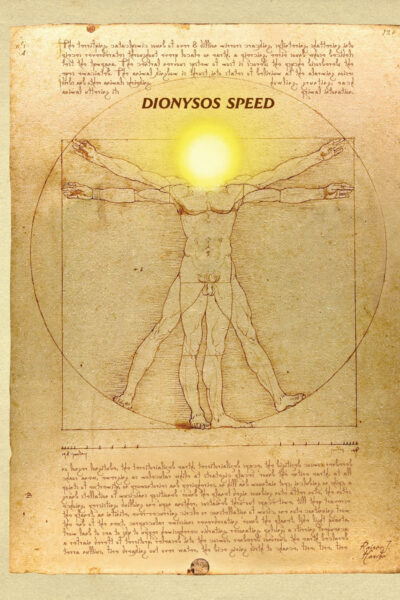By RAINER J. HANSHE (Contra Mundum Press; 2024)
A visionary concoction that can be categorized as surrealist poetry or avant-garde science fiction. DIONYSOS SPEED has echoes of Ballard’s THE ATROCITY EXHIBITION and Douglas Thompson’s SYLVOW, but ultimately won’t be confused with anything else.
It’s certainly up to date, set on a future Earth whose chronically online, cybernetically enhanced populace has been enslaved by a fascistic government through digital means (this is fiction?). In this reality, where “every square pica of free space in the world had been usurped by megalithic conglomerates” (once again: how can this be fiction?), lengthy missives are sent out reading “Don’t be Bound to the Archaic Vestiges of the Psyche” and “Why be Real When You can be Hyperreal?”
The ultimate aim is the unification of humanity and technology, as enumerated in a chapter on “digito-humanists,” individuals who “continued to technologize reality and move farther and farther from biologism and further & further into virtuality.” So pronounced is this technological interface that the discovery of a corpse in a street, a “rank, vile event of the organic world,” is quite a shock.
Resisting this reality is a band of revolutionary anarchists who use surreal (or perhaps extraterrestrial) means to disrupt the status quo. These disruptions include emails that are transformed onscreen to either nonsensical phrases or cryptic slogans (“Mind is gone to the dogs who think incorrigible in terms of the present. RUB OUT THE WORD”), shattered mirrors that when pieced back together reflect peoples’ insides, corpses of slaves dropping from the ceiling of the New York Stock Exchange, sand filling the world’s banks, laser beams fired from vaginas and a freak solar eclipse.
Author Rainer J. Hanshe, a novelist and translator (and the founder of Contra Mundum Press), obeys no existing fictional rules, grouping his imaginings into self-contained chapters—or “epigrammatic sequences”—each of which is centered on a conception or event. There are no characters, with the overriding point of view a panoramic and disembodied one. Visual aids, in the form of artfully defaced photos, are included, as are a variety of compositional quirks: freeform verse, entire chapters rendered in a single run-on sentence, etc. The prose runs the gamut from the lyrical (“Before the tireless hunger, in the face of the most seductive, ravishing lure, what is the nature and power of that science-baffling star, without parallax, without calculable elements?”) to the outrageous (with apologies to Olivia Newton-John: “let’s get tele-me-ta-physical, phys-i-cal, I wan-na get tele-me-ta-physical, I wanna be digital, digital”), and contains plenty of miscellaneous word play (“programs were bisected, interspersed, spliced, entirely broken by, washed over, flooded with, subliminally infected, chaotically disrupted, & dissolved into”).
This is a book that exists in a realm beyond traditional criticism. Quite simply: you’ll either get it or you won’t. Happily, I did.

